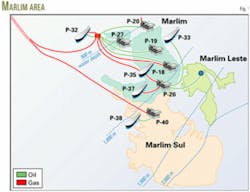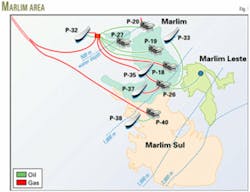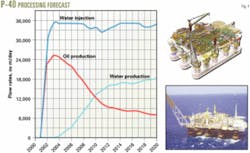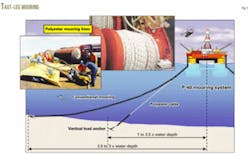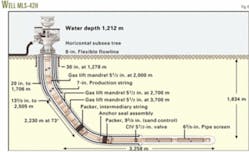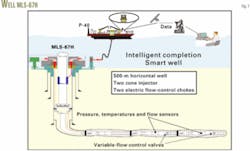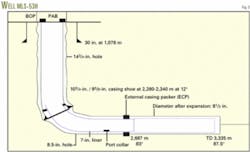Based on a presentation to the Deep Offshore Technology Conference, Marseille, Nov. 19-21, 2003.
To lessen risks, Petróleo Brasileiro SA (Petrobras) selected a four-module program for developing its large deepwater Marlim Sul oil field.
Discovered in 1987 in the Campos basin off Brazil, the field has been under development since 1994. It contains 1.47 billion boe of proved reserves and an additonal 1.15 billion boe of probable reserves. It currently produces 185,000 bo/d, 13% of Petrobras' oil production in Brazil, and 2.5 million cu m/d of gas.
Lying in 800-2,600 m water depths, the field contains 14 reservoir blocks in a large 600-sq km area that require various development techniques because of the large variability in water depth and oil characteristics.
The main development challenges include:
- Subsea flow through long flowlines at low temperatures.
- Drilling extended-reach wells or horizontal wells in unconsolidated, thin sandstones lying under a thin sediment section.
- Sand control systems for preventing sand production.
- Availability of lay-support vessels, drilling platforms, deepwater equipment, etc.
- Geological and reservoir uncertainties during technical and economical feasibility studies.
Current plans
In 1985, Petrobras discovered the Marlim field in 853 m of water. The Marlim Leste discovery, 1,260 m of water, followed in 1986, and in 1987 Petrobras discovered the Marlim Sul field in 1,124 m of water (Fig. 1).
The field development plan includes four modules (Fig. 2).
The first phase of the Marlim Sul development, Module 1, consists of 35 wells (21 producers and 14 water injectors). As of September 2003, in operation were 14 producers and 9 water injectors in 1,000-1,500-m water depths. Of these wells, 20 tie-in to the P-40 semisubmersible floating production unit (FPU). Another 3 wells connect to the P-37 and P-26 FPUs, moored in the neighboring Marlim oil field.
In mid-2004, Petrobras plans to start operating the Marlim Sul floating production, storage, and offloading (FPSO) vessel. The vessel will increase the oil producing capacity to about 250,000 b/d from the current 185,000 b/d. Nine of the 35 wells in Module 1 will tie into this FPSO.
Module 2 development started in 1999 with two-wells connected to an FPSO for an extended production test. This pilot test lasted until December 2001 and provided important reservoir and production information. To reduce development risks, Petrobras also drilled several appraisal wells in the Module 2 area.
The company expects to start producing from Module 2 in 2006. Module 2 will include 10 producers and 9 injectors in 1,200-1,700 m water depths. The producers will tie into an FPU capable of processing 180,000 bo/d.
The initial feasibility studies indicate Module 3 will need 23 wells. This phase has many technological challenges that will require innovative solutions. The area is in deeper 1,700-2,500 m water depths and the reservoirs contain a highly viscous, heavier 14-18° crude.
The wells in these ultradeep waters will require long horizontal laterals drilled in a thin sedimentary section.
Feasibility studies for Module 4 will follow, with production expected to start in 2012.
Reservoir engineering
Marlim Sul has many separate reservoirs. Petrobras initially identified 20 reservoirs but newer interpretation indicates that the field has 14 separate blocks, consisting basically of Oligo-miocene and Eocene turbidity sandstones.
Gas in solution provides the producing mechanism, so that the reservoirs require water injection for maintaining reservoir pressure.
The pay zones typically are thin, between 10 and 20 m, with a maximum 100-m thickness. The zones have excellent rock quality with 25-38% porosity and 2-16 darcy permeability. The oil gravity is 23-27° in Module 1, 20-22° in Module 2, and 14-18° in Module 3.
The development strategy involves having lateral continuity between producers and injectors. This requires both seismic control and high-performance horizontal wells.
Petrobras obtained 3D seismic during the exploration phase and used it as a basis for determining exploratory and appraisal wells locations. These well provided information for calibrating the seismic interpretation and the geological characterization.
The appraisal wells in Marlim Sul reduced data uncertainties because of the reservoir fluid and rock samples collected and the logging information obtained.
Pilot production systems allow evaluators to obtain important reservoir information, besides contributing to production and revenues. But, these systems do not provide all necessary reservoir information and using only this information may lead to incorrect conclusions. The Marlim Sul development, therefore, has used an approach that evaluated various alternatives.
This evaluation led to adopting horizontal wells for developing all of the modules.
Because of the effective synergy between the reservoir and well construction groups, the groups have reduced the horizontal well damage ratio to an expected 1.5 from the initially expected 2, with most wells now having a damage ratio less than 1.
These low damage ratios have contributed to P-40 reaching its processing limit with fewer than the initially planned 30 wells. It was therefore necessary to install another processing unit, FPSO Marlim Sul, to tie into the other 9 wells.
Well construction
Module 1 has horizontal wells with potential productivity up to 5,000 cu m/day (30,000 b/d). Sand control and openhole gravel packs are mandatory in the wells because of the unconsolidated sandstone reservoirs.
The typical casing program has 30-in. conductor casing, 133/8-in. surface casing, 95/8-in. production casing, and a 51/2-in. base-pipe screen that is gravel packed in an 81/2-in. horizontal section.
Until 1997, Petrobras had drilled only 19 horizontal wells in water depths up to 900 m. Most of these were in shallow water. Now, it plans to drill all Marlim Sul with horizontal sections of at least 500 m.
Its standard horizontal well design has four sections:
- Three joints of 30-in. built-in conductor.
- A 171/2-in. hole with 133/8-in. casing.
- A 121/4-in. hole with 95/8-in. casing to the top of the reservoir at about 90°.
- An 81/2-in. hole with 63/8-in. screen (51/2-in. base pipe) and openhole gravel pack.
Azimuth tools with an inclination sensor positioned near the bit have reduced the time spent on navigation while drilling the horizontal section. Also rotary steerable tools have improved the quality and lessened the time for drilling the build up and horizontal sections.
These tools allow the bit to stay inside the pay zone and obtain a smoother trajectory. The polycrystalline-diamond compact (PDC) bits used have increased penetration rate and bit life.
The drillstring includes logging-while-drilling (LWD) tools with gamma ray, resistivity, density, and sonic sensors. Drillers use a pressure-while-drilling (PWD) sensor to check for hole cleaning.
Petrobras no longer uses the practice of drilling a vertical pilot hole to check for reservoir depth before drilling the horizontal lateral. Now, the practice, which has reduced total drilling time, is to drill the pilot in the high angle section and then set the 95/8-in. casing shoe at the top of the reservoir.
Well completion
Completion programs typically use only one packer, inside the casing, whenever it is not planned to abandon a well temporarily. A well includes a tubing seal receptacle (TSR), without a packer specified. The packer is inside the horizontal lateral.
Wells have 65/8-in. tubing instead of 51/2-in. inside the 95/8-in. casing.
All producers typically have a permanent downhole gauge (PDG) and a temperature and pressure transducer (TPT). Injectors have a digital TPT inside the subsea tree.
Petrobras does not include a downhole safety valve (DHSV) in wells because its Marlim Sul reliability study indicated that DHSVs were unnecessary for isolated wells. Eliminating the DHSV reduces operating expenditures.
Damage ratio
Petrobras stimulates all injectors in Marlim Sul to reduce the damage ratio. In the past, these jobs were done through wash pipe without mechanical diverting equipment. This often did not achieve damage ratios less than 2. But new technologies with diverter equipment are giving better results.
Selective acid-stimulation tools allow stimulating preferentially in multiple stages in the same run. This reduces the time spent as well as providing good diversion and consequently efficient damage removal.
Petrobras usually does not stimulate Marlim Sul producing wells.
Chrome casing
Because of the presence of CO2, producing wells have 13% chrome production casing for the 10 first (lower) joints. The chrome joints prevent damage to the casing below the packer from the produced fluids and galvanic corrosion.
In the program, Petrobras increased the initial 5 joints to 10 joints to permit setting another packer inside the 13% chrome section if it became necessary to redrill the horizontal lateral and run a new gravel-pack assembly.
Injection wells have a chrome 1% chrome injection string and a 13% chrome gravel-pack assembly. The wells, to prevent galvanic corrosion, also include fiberglass internally cased transition joints in the interfaces between the injection string and gravel-pack assembly and between the injection string and 13% chrome subsea tree.
Subsea tree
Marlim Sul producing and injection wells have guidelineless subsea trees with three independent vertical connection modules (VCMs) for 1,500-m water depth. A temperature and pressure transducer (TPT) monitors the production and annulus bores.
The installation of subsea production trees on injection wells provides advantages for controlling hydrates and also provides more flexibility in planning. Petrobras requires that subsea tree manufacturers test all valves with gas, in order to reduce hydrate risk.
Petrobras uses a production adapter base (PAB) set on the wellhead housing before it installs the subsea tree. This allows it to connect-disconnect flowlines directly to and from the PAB, without depending on having the subsea tree installed.
The PAB has the other advantage of allowing the subsea tree to be pulled for repair without needing to disconnect the flowlines.
The conventional PAB is set after drilling the 121/4-in. hole because its drift is smaller than the 121/4-in. hole. It is set after drilling the 121/4-in. and pulling the BOP (blowout preventer) stack. The BOP is rerun after installing the PAB.
Petrobras technicians have designed a new PAB with a 121/4-in. drift that will be installed after the 171/2-in. phase (133/8-in. casing) and before running the BOP. The 121/4-in. hole is drilled with the PAB and BOP installed. This practice saves about 4 days of rig time.
Artificial lift
The artificial lift method for both Modules 1 and 2 is continuous gas lift. Produced gas after being treated and compressed on the FPU enters a surface gas-lift manifold that distributes the gas to the wells annuls lines. Chokes control the gas rate and there is no subsea gas distribution manifold.
All production strings have a single orifice gas-lift valve.
Module 2 will include gas-lift automation for optimizing production and multiphase metering for increasing reservoir management control.
Planned maximum gas-lift injection rates are 200,000 and 250,000 cu m/ day/well, respectively, in Modules 1 and 2.
Wax
Analysis reveals that oil from Modules 1 and 2 has about a 20° C. wax appearance temperature (WAT), indicating a potential for wax deposition inside the flowlines.
To prevent wax deposition, the flexible flowlines have thermal insulation. Also, low-density pigs can remove mechanically some wax deposition. These pigs are used because annulus lines and production lines have different diameters. The pigs are pumped through the annulus lines from the FPU to the subsea tree and return through the production line, without interrupting the production.
Other options are also available in case the wax deposition decreases production. For instance, Petrobras has developed and patented a nitrogen generating system that consists of an in situ chemical reaction between two nitrogen salt-containing aqueous solutions. The reaction generates a large amount of heat and nitrogen gas that fluidizes the wax deposition and consequently unplugs the flowline.
Hydrates
Hydrate crystals that form and plug lines and valves pose major problems in deep water. Removal is difficult because of the high hydrostatic pressures and low temperatures in this environment.
In Marlim Sul, the thermally insulated flowlines maintain higher temperatures during flow. This delays the temperature drop in case flow ceases, thus providing more time for reducing the pressure and fluids that make hydrate formation possible.
The process facilities have a dehydration system and a means to check the gas humidity before the gas enters the gas lift or export lines. This helps minimize the possibility of forming hydrate.
Also, operators can reduce the hydrate risk by injecting a thermodynamical hydrate inhibitor (ethanol) through the electrohydraulic umbilical from the FPU to the subsea tree. The annulus line serves both as gas lift line and also as an auxiliary line for displacing fluid through the production flowline.
Flowlines
Marlin Sul has flexible flowlines that have been upgraded for water depths of 1,500 m under dynamic conditions and up to 2,000 m under static conditions.
Modules 1 and 2 have 6-in. or 8-in. static and riser flexible flowlines. An offshore laying simulation (DIP tests) qualified them for this application.
The Marlim Sul development does not included any subsea manifolds because of the high well flow rates and short distances between wells and FPUs. This also eliminates the extra cost of manifolds.
The program in Module 1 allowed for both bundle and individual flowline launching. For Module 2, Petrobras plans only individual launching of flowlines mainly because of the flexibility in having a wider range of lay support vessels (LSVs) available that can lay individual lines. Also, pulling a single line for maintenance is easier.
So far, the project has had no severe wax problem in the 6-in. production flowline. Therefore the new wells will include a 21/2-in. gas-lift line instead of a 4-in. line.
Each Module 2 subsea tree will have three vertical connection modules (VCMs).
Petrobras developed and in 1992 introduced the vertical connection system (VCS). After some improvements, it has used the VCS in Marlim Sul.
VCS is a diverless system (Fig. 3) that is simpler and costs less than other approaches. In the system, the approaching and positioning phases depend more on operational procedures than equipment, and the locking and sealing phases include connectors similar to those on the subsea trees and wellhead systems.
The flowline, instead of being pulled to the position, is slacked off above the sea bottom. This allows the VCM to be moved towards the wellhead position without pulling the line.
A cable or drillpipe string can handle the VCM.
FPU
Petrobras 40 (P-40) is a semisubmersible platform that can process 150,000 bo/d, inject 220,000 bw/d, and compress 212 MMcfd of gas. Fig. 4 shows the forecast for the production processed by P-40.
Converted in 2000 from a heavy-lift crane barge, P-40 started operations in Marlim Sul December 2001.
P-40 is taut-leg moored (Fig. 5).
The taut-leg system is one of the technologies validated in Marlim Sul. Petrobras pioneered its use and currently has this system installed in four production units.
Moreover, the company plans to use it in many other units in the future because this system allows for mooring in up to 3,000 m of water.
Its main advantages are:
- Reduced mooring radius, occupying less subsea area.
- Increased ratio between the load capacity and the total cost.
- Reduced platform offset movement.
This system consists of polyester ropes as part of the mooring lines and a vertical loaded anchor (VLA), an innovation developed by Petrobras and its suppliers. The VLA is designed to work embedded 30 m below the sea bottom.
In Marlim Sul, P-40 and P-38 have taut-leg systems. P-40 is anchored in 1,080 m water depth with 16 lines. Each mooring line has 1,700 m of polyester rope in a total length of 2,150 m. The average anchoring radius is 1,800 m.
A subsea electrical and optical umbilical for power, data and telecommunication transmission interconnect P-40 and P-38. Some power generated on P-40, using the produced gas, is transferred to P-38.
P-40 discharges effluents according to environmental specifications. The maximum in Marlim Sul has been 15 ppm, with the maximum month average of 8 ppm. The acceptable limit it 20 ppm.
Well MLS-42H
The MLS-42H extended-reach well (ERW) in Marlim Sul has reduced flowline length, thereby minimized the effects of low subsea temperature and pressure losses on oil flow.
Petrobras completed the first offshore ERW in Brazil, Well MLS-42H, in 2001 (Fig. 6). The well, completed in 1,212 m of water, has a pay zone at 2,862 m TVD and measured TD of 5,211 ft. It has a 3.258-m departure and an 89° inclination.
Fig. 6 shows how the well was completed.
For drilling, a Petrobras simulator for wellbore stability, SEST, and a well cleaning simulator, SIMCARR, correlated well with the actual drilling results.
Drilling with 65/8-in. and 51/2-in. strings contributed to the successf because these string sizes minimized hydraulic constraints especially in the critical 16-in. and 121/4-in. holes.
Drilling the 16-in. hole was the most difficult part of the operation because of the build angle (trajectory control) and wellbore cleaning. Optimized fluid parameters and tandem pills were important for keeping cuttings transport under control. Drilling with low build rates contributed to maintaining torque and drag within safety limits. The drilling and completion of the well took 166 days, and cost less than $27 million.
MLS-42H reached a peak production of 43,00 bo/d in December 2001 and now produces about 36,000 bo/d, which is the highest rate for a well off Brazil.
The well has a productivity index (PI) of more than 150 bbl/d/psi. It produces from a zone with 34% porosity and 1,308 md permeability. The oil gravity is 24°, and the GOR is 530 scf/stock-tank bbl.
The distance from wellhead to P-40 is 7-km.
The high production rates result, in a large part, because of the large 8-in. production riser and flowline combined with a large 7-in. production string.
MLS-67H
Petrobras installed the first subsea intelligent completion off Brazil in Well MLS-67H (Fig. 7).
The well is a two-zone injector with a 500-m horizontal lateral. The well is in 1,170 m and has a 2,714-m TVD and 3,605-m MD.
The injection string has two electric flow-control chokes that allow selective injection to each reservoir, so that it is possible to control the flow rates individually for each zone, altering them according to the pressure monitored or reservoir requirements.
This well started injection in August 2003 and is injecting 5,000 bw/d into the MRL-100 and 8,200 bw/d into MRL-260 reservoirs.
BarBi Well
The MLS-53H well (BarBi well) has a new design that lessens rig time by reducing the well sections drilled. BarBi is named for Petrobras engineers Paulo Barata and Luis Bianco, who proposed the design.
The new design has three sections: a 30-in. conductor, a 103/4-in. casing, and a rigid 7-in. liner combined with a 51/2-in. expandable sand screen (Fig. 8).
The well construction includes:
- Drilling a 36-in. hole and cementing or jetting in 30-in. casing, with a 163/4-in. slender well housing.
- Drilling a 143/4-in. hole to 2,350 m with combined casing string of 10 joints of 95/8-in. at the bottom, one 133/8-in. joint on top, and 103/4-in. joints.
- Setting the PAB and installing the BOPs.
- Drilling an 81/2-in. hole to 3,335 m, including build and horizontal sections, and setting a 7-in. liner combined with 51/2-in. and 81/2-in. expandable screens for sand control. An external casing packer is set above the 7-in. shoe. Also the 7-in. liner has a port collar for cementing the liner.
- Installing the 7-in. production string and running production tests after installing the subsea tree.
Petrobras finished the first such well in November 2003 and currently is completing a second such well. The Module 2 drilling campaign that will start in September 2004 adopted this configuration for all producing wells.
Module 3
Module 3 requires a more complex development scheme than Modules 1 and 2.
Some alternatives being studied include:
- Drill longer and larger bore horizontal and extended-reach wells, especially inside thin and unconsolidated sandstone reservoirs and under thin sediment cover. New sand-control equipment will be needed in this low fracture gradients environment.
- Improve intelligent completion technology to make it less expensive and more reliable. Include possibly optical technology.
- Study the potential of multilateral wells for developing heavy oil, although multilaterals are not planned for Module 3 at this time.
- Design subsea equipment for 2,000-m water depth with such technology as large-diameter swivels, valves, and risers. Also develop pull-in and inspection procedures for both flexible and rigid risers.
- Evaluate thermal insulation, line heating, and multisize pigging for preventing wax deposition at the lower temperatures foreseen for Module 3.
- Optimize production by automating gas lift, and installing multiphase meters.
- Develop new techniques for dealing with hydrates.
- Upgrade electric submersible pump boosting equipment for ultradeep water. Alternatives also include the hydraulic submersible pump (HSP) and multiphase pumps.
- Optimize the designs for large-capacity production topsides, with such equipment as subsea separators, new solutions for handling produced water injection and raw water injection, and new techniques for discharging produced water.
- Developing new safety valves for gas lift and gas export lines to prevent or reduce flow back in case of damage or failure in gas flowlines near the topsides.
Petrobras' technological programs created to analyze and overcome these challenges include:
- PROCAP-3000: Technological program on ultradeep water exploitation systems.
- PRAVAP: Technological program on enhanced reservoir recovery.
- PROPES: Technological program on heavy oil.
- PROAMB: Technological program on environment.
These programs involve the whole organization and, normally, are led and conducted by the Petrobras Research and Development Center (CENPES) in cooperation with the operating units.
Acknowledgments
The author thanks Petrobras for permission to publish this article. Special thanks are due to everyone who contributed with data, information, and consulting support for this article.
References
- Almeida, M.A., et al., "Drilling and Completion of an Extended Reach High Rate Deepwater Producer Well in Campos basin," DOT, New Orleans, 2002.
- Mendonça, J.E., "Marlim Sul Field: An Ultra-Deepwater Development," 17th World Petroleum Congress, Rio de Janeiro, Sept. 1-5, 2002.
- Rosa, F.S.N., et al., "New Well Design Using Expandable Screen Reduces Rig Time and Improves Deep Water Oil Production in Brazil," SPE/IADC Drilling Conference, Amsterdam, Feb. 19-21, 2003.
- Priandi, G.B., and Dias, R., "Planning the Deepwater Operations and Evaluating the Latest Technologies in Campos basin," Offshore Drilling Technology, Aberdeen, June 17-18, 1998.
The author
Gilson Batista Priandi is well construction manager for the Marlim Sul production asset in the Petrobras E&P Rio de Janeiro business unit. He has held various positions with Petrobras both in Brazil and Bolivia. Pirandi has a BS in civil engineering.
